Knee Exercises
Omaha Knee Exercise Information – Dr. Darren R Keiser MD
If my Knee hurts, why Exercise?
Having strong, flexible muscles is the best way to keep knees healthy and prevent further injury.
Strength
Strengthening the muscles that support your knee will reduce stress on your knee joint. Strong muscles in the front of your thigh (quadriceps) and back of your thigh (hamstrings) help your knee joint absorb shock. The less strain on your knee, the better the chances are for pain relief and preventing further injury.
Flexibility
Stretching the muscles that you strengthen is an important part of preventing injury. Strengthening exercises build muscle to help support your knee, but can also tighten the muscles. Tight muscles are more prone to injury. Gentle stretching after strengthening exercise reduces muscle soreness and will keep your muscles long and flexible.
How do I start exercising?
Your doctor or physical therapist will tell you which exercises are right for you.
Start slowly. Building muscle strength takes time. As you get stronger, gradually increase the number of exercise repetitions or add weight to an exercise.
Do not ignore pain. You should not feel serious pain during an exercise. You might feel discomfort because you are challenging your muscles, but not pain. If an exercise hurts, stop the exercise.
Do not overdo it. You should not feel serious pain after exercise. It is typical to feel stiff or a bit sore the day after you exercise. If you feel so sore that it is difficult to move, then you have overdone your exercise. Rest is the best thing for your sore muscles.
Ask questions. Talk to your doctor or therapist if you have any pain or are unsure of how many exercises to do, or how often to do them.
Strengthening Exercises
Warm up with 5-10 minutes of low impact activity, like walking or cycling, before doing these exercises
Straight-Leg Lift
 You should feel this exercise mostly in the front of your thigh.
You should feel this exercise mostly in the front of your thigh.
Lie on your back with one leg bent and the other straight. Tighten the thigh muscles in your straight leg and slowly lift it until it is about a foot off the floor. Hold it for 3 to 5 seconds. Slowly lower your leg to the floor. Repeat and switch sides.
Do: Keep your upper body relaxed and tighten your stomach muscles to keep your low back flat against the floor.
Do not: Arch your back. Do not lift your leg too high with a jerking motion.
Single-Leg Dip
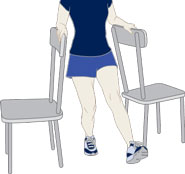 You should feel this exercise in the front and back of your thigh, hip, and buttocks.
You should feel this exercise in the front and back of your thigh, hip, and buttocks.
Place two chairs on either side of you to help with balance. Lift one leg slightly in front of you. Plant your weight on the other leg. Slowly lower yourself down a few inches, pushing your weight onto the heel of your supporting leg. Hold for 3 to 5 seconds. Slowly straighten up. Repeat and switch sides.
Do: Sit back as if there was a chair behind you.
Do not: Let the knee of your supporting leg move forward over your toes.
Hamstring Curls
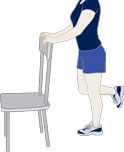 You should feel this exercise at the back of your thigh.
You should feel this exercise at the back of your thigh.
Hold on to the back of a chair for balance. Plant your weight onto your supporting leg. Lift the other foot and bring the heel up toward your buttocks. Hold for 3 to 5 seconds. Slowly lower your leg. Repeat and switch sides.
Do: Keep your knees close together.
Do not: Lock the knee of your supporting leg. Do not bring your heel up past a 90 degree angle.
Knee Stabilzation Series
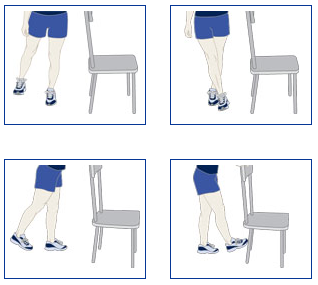 You will feel these exercises on all sides of your thigh, your hip and buttocks.
You will feel these exercises on all sides of your thigh, your hip and buttocks.
Hold onto the back of a chair for balance. Slightly lift one leg. Plant your weight on your supporting leg. Tighten your thigh muscles in your lifted leg and slowly move it in the direction shown. Hold for 3 to 5 seconds. Slowly return to start and repeat. Turn your body 90 degrees to begin the next exercise in the series.
Do: Focus on your supporting leg. It is working just as hard as the moving leg.
Do not: Lock the knee of your supporting leg. Do not arch your back or lean to either side during these exercises.
Wall Squat
 You should feel this exercise mostly in the front of your thighs.
You should feel this exercise mostly in the front of your thighs.
Stand with your head, back, and hips against a wall. Step your feet out about 2 feet from the wall, hipwidth apart. Slowly slide down the wall until you are almost in a sitting position. Hold for 5 to 10 seconds, then slowly slide up. Repeat.
Do: Keep your abdominal muscles tight. Hold the position longer as you get stronger.
Do not: Slide your hips down lower than your knees. Do not let your knees move forward over your toes.
Step Ups
 You should feel this exercise in the front and back of your thigh, your hip, and buttocks.
You should feel this exercise in the front and back of your thigh, your hip, and buttocks.
Use a 6-inch high stool or platform. Step one foot onto the platform. Lift your other foot off the floor, letting it hang loosely off the platform. Try to hold for 3 to 5 seconds. Slowly lower your hanging foot to the floor, then bring your stepping foot down. Repeat and switch sides.
Do: Make sure when you step up that your whole foot is on the platform.
Do not: Lock the knee that is stepping on the platform.
Stretching Exercises
Quadricep Stretch
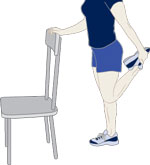 You should feel this stretch in the front of your thigh.
You should feel this stretch in the front of your thigh.
Hold on to a wall or the back of a chair for balance. Lift one foot and bring your heel up toward your buttocks. Grasp your ankle with your hand and pull your heel closer to your body. Hold the stretch for 30 seconds.
Do: Keep your knees close together. Stop bringing your heel closer when you feel the stretch.
Do not: Arch or twist your back.
Hamstring Stretch
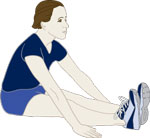 You should feel this stretch at the back of your thighs and behind your knees.
You should feel this stretch at the back of your thighs and behind your knees.
Sit up tall with both legs extended straight in front of you. Your feet are neutral — not pointed or flexed. Place your palms on the floor and slide your hands toward your ankles. Hold for 30 seconds.
Do: Keep your chest open and back long. Reach from your hips. Stop sliding your palms forward when you feel the stretch.
Do not: Round your back or try to bring your nose to your knees. Do not lock your knees.
Article URL: http://orthoinfo.aaos.org/topic.cfm?topic=A00564&webid=2FDDE053
